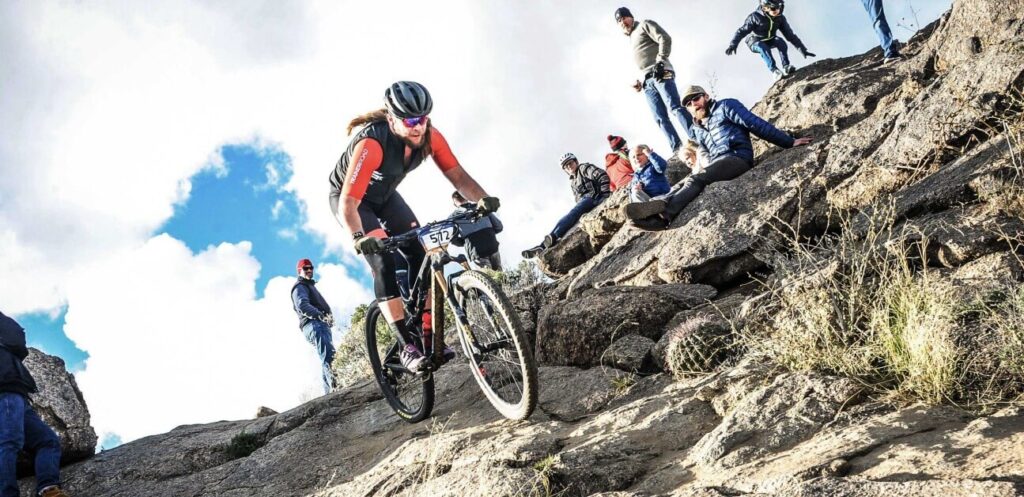5 Best Workouts for Mountain Bikers

Get prepared for mountain biking’s unique and demanding physical challenges with these five great workouts for mountain bikers. Use them to sharpen your mountain bike fitness, build upon important skills, or introduce off-road-specific interval training to your schedule.
5 Cycling Workouts for Mountain Bikers
How to Become a Faster Mountain Biker
Mountain bikers encounter a variety of physical challenges out on the trail. The technical terrain and varied courses call for quick bursts of power, intermittent intensity, and a wide range of repeated outputs. Off-road athletes also need to have a strong aerobic energy system to sustain high power outputs over long distances and to endure the repetition of the trail.
Adaptive Training
Get the right workout, every time with training that adapts to you.
Check Out TrainerRoadThe best way to attain the fitness necessary for these demands is with a structured training plan specific to mountain biking. Spanning a season, a structured mountain bike training plan is composed of workouts that progressively target the energy systems used in mountain biking. With integrated rest and strategically organized training stress, a structured training plan is designed to bring about specific physical adaptations. Equipped with these capabilities, you can conquer any trail, goal, or race.
All in all, a structured training plan is the most efficient and effective way to become a faster cyclist and reach your mountain bike goals. It’s not the only way to get started with training, though. If you’re unsure about committing to a season-long structured training plan, you can still achieve some significant physical benefits with a few fundamental workouts.
5 Go-To Workouts for Mountain Bikers
These five workouts from our off-road-specific training plans can do exactly that. These workouts are a good general representation of the power needed to handle mountain biking’s various physical demands, making them a solid introduction to interval training for off-road athletes. If you’ve already done some off-road-specific training, these workouts are also good go-to workouts to sharpen your established fitness.
When completing these workouts, it’s important to remember that their combination lacks the progressive structure that a training plan has. Which, in short, means they don’t have integrated rest, and if you don’t have established fitness, they may be too challenging to complete. If the workouts used in these examples aren’t in your current physical range, try using the TrainerRoad workout library or TrainNow to find a workout with less stress but the same structure.
1. Sustained VO2 Max Intervals

Sustained VO2 Max intervals challenge your aerobic and anaerobic energy systems—both of which are key energy sources in mountain biking. By forcing you to maintain an uncomfortably high amount of power for a prolonged period of time, this workout is a time-efficient approach to VO2 Max training. This type of interval training also mimics the short, punchy efforts that frequent off-road terrain.
A good example of a sustained VO2 Max workout is Denali +3. Denali +3 has five six-minute intervals spent at 110-112% of your functional threshold power (FTP). Each VO2mac interval is followed by six-minute intervals spent in the active recovery zone. This workout aims to extend your supra-threshold power by increasing your anaerobic and aerobic work capacity using a short but intense approach.
2. Aerobic Endurance

While intensity and variability are typical to mountain bike racing, you can’t get very far with either capability unless you have an established aerobic base. Actively completing endurance-based workouts that challenge your aerobic energy system is one of the best ways to build robust endurance.
Collins +1 is an aerobic exercise designed to reinforces your aerobic foundation. This ride is 75 minutes of aerobic endurance riding spent between 65-75% of your FTP. This workout also includes three late-ride sprints to help you brush up on your sprinting form late in a longer ride. Workouts like these help cultivate a strong, wide aerobic base that includes all physiological adaptations inherent in long, steady, low-intensity riding. As you get stronger, you extend the duration of your aerobic rides; alternatively, if you need something easier, feel free to swap this workout for a shorter aerobic workout.
3. Hard-Starts

Mountain biking actively forces you to repeatedly output sharp bursts of power, even when you’re already pushing a high power out. Workouts with all-out sprinting intervals that mimic hard starts are a great way to address this power necessity. Even if you’re not racing, being able to mimic a hard start is a great skill for navigating up and over technical terrain and pushing up sharp and punchy climbs.
Workouts like Backbone +3 are sprinting start workouts. This workout, in particular, includes 8×90-second race-start intervals. These intervals begin with 30 seconds at 180% of your FTP followed by 1 minute at 115% of your FTP. These are perfect for athletes who want to race mountain bikes as they offer numerous chances to test and fine-tune your initial acceleration capabilities. If you’re looking for a slightly different variation of this workout, you can find a handful of these hard-start workouts in the TrainerRoad library.
4. Sustained Tempo

While off-road athletes rarely stick to one consistent power for very long, they still spend a lot of time in the sustained power zones throughout a long ride or race. Having strong capabilities in these sustained power zones like the sweet spot zone, the tempo zone, and the threshold zone is necessary for every mountain biker.
Tempo intervals like Glassy -2 aim to increase aerobic capabilities via reasonably long workouts that are mildly more intense than your typical aerobic endurance workout. This workout, in particular, includes four fifteen-minute intervals between 68-83% of your FTP with five minutes of recovery in between them. While rather uncomfortable, this workout isn’t too stressful. Overall, it keeps you at a productive work level for a reasonable duration. The slight variation in these sustained intervals provides a bit of variation you might find in a mountain bike race too.
5. Race Simulation

If you’re looking for a challenging workout to test your off-road fitness and tax the system, Bear is a variable over-under workout that’s perfect for just that. In the workout description, TrainerRoad’s Coach chad refers to these as “race simulations.” because they mimic the race intensity you might face during a short track race or an Olympic-distanced cross-country race.
“VO2max workouts in general target your aerobic power, pain tolerance, muscular recruitment, and muscle endurance in a manner that coaxes you into doing a whole lot of repeats. Race simulation workouts like this one allow you to accumulate a hefty amount of time at VO2max power, all inside a reasonably short workout.”
Looking for more workout suggestions from the TrainerRoad workout library? Check out Coach Chad’s 5 Favorite Workouts to Increase Your FTP for additional options.
